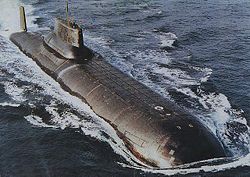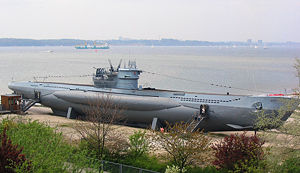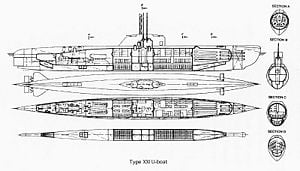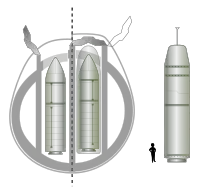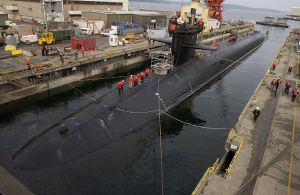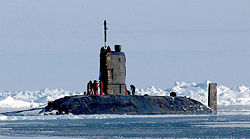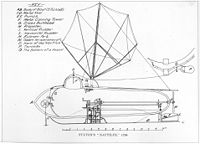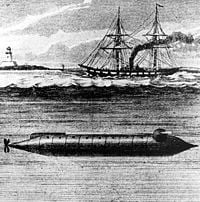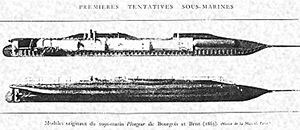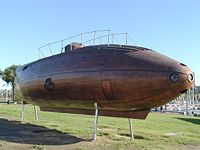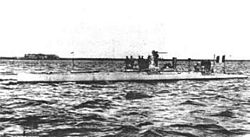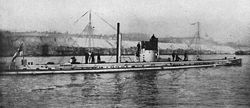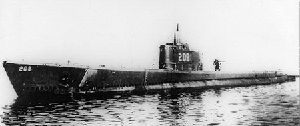Submarine
A submarine is a specialized watercraft that can operate underwater at very high pressures beyond the range of unaided human survivability. Submarines, first widely used in World War I, are used by all major navies today, especially the American, Russian and British navies. Civilian submarines and submersibles are used for marine and freshwater science and for work at depths too great for human divers.
Submarines are always referred to as "boats" except in some formal documents. The term U-Boat is sometimes used for German submarines in English. This comes from the German word for submarine, U-Boot, itself an abbreviation for Unterseeboot (âundersea boatâ).
Submarines encompass one of the largest ranges in capabilities of any vessel. They range from small one- or two-man vessels that can examine the sea floor for a few hours to the Russian Typhoon class, which can remain submerged for half a year and carry nuclear missiles capable of destroying multiple cities. There are also specialized submarines such as rescue submarines (like the Deep Submergence Rescue Vehicle (DSRV) or Priz-class) and tiny one-person human powered subs intended for competitions between universities. An older device for use in underwater exploration, salvage, construction and rescue is the diving bell.
The word âsubmarineâ was originally an adjective meaning "under the sea." Some firms who make diving gearâbut not parts for submarinesâcalled their work "submarine engineering." âSubmarineâ as a nounâmeaning a submersible craftâoriginated as short for "submarine boat" and older books such as Jules Verneâs Twenty Thousand Leagues Under the Sea always use this term.
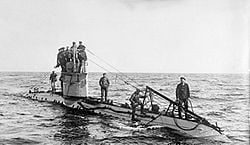

Civilian submarines and submersibles
Civilian submarines are usually much smaller than military submarines. Tourist submarines work mainly in tropical resort areas or other areas with clear water and good visibility. By 1996 there were over 50 private submarines operating around the world, serving approximately two million passengers a year. Most of them carried between 25 and 50 passengers at a time and sometimes made ten or more dives per day. In design, these submarines borrow mainly from research subs, having large portholes for viewing and often placing significant mechanical systems outside the hull to conserve interior space. Nonetheless, even aboard tourist submarines the seating can be rather cramped. They are mainly battery-powered and very slow.
As of January 2005, the largest tourist submarine in use was the Atlantis XIV based out of Waikiki beach. The largest Atlantis-class submarine of its fleet, launched in 1994, can carry 64 passengers and three crew (two guides and a pilot) to 150 feet (50Â meters) deep off the shores of the island of O'ahu in Hawaii. There, tourists can view a great number of ocean specimens living around artificial reefs.
In common usage, "submarine" means a ship that operates above and below the surface, untethered. Underwater vessels with limited mobility, intended to remain in one place during most of their use, such as those used for rescue, research or salvage purposes are usually called "submersibles." Submersibles are typically transported to their area of operation by surface ships or large submarines and have a very short range. Many submersibles operate on a "tether" or "umbilical," remaining connected to a tender (a submarine, surface vessel or platform).
Bathyspheres are submersibles that lack self-propulsion and are used for very deep diving. A predecessor of the bathysphere, the diving bell, consisted of a chamber with an open bottom, lowered into the water. Bathyscaphes are self-propelled deep-diving submersibles reliant on a mother ship on the surface.
A fairly recent development, very small, unmanned submersibles called "marine remotely operated vehicles" (MROVs) are widely used today to work in water too deep or too dangerous for divers. For example, remotely operated vehicles (ROVs) repair offshore petroleum platforms and attach cables to sunken ships to hoist them. A thick cable providing power and communications tethers these remotely operated vehicles to a control center on a ship. Operators on the ship see video images sent back from the robot and may control its propellers and manipulator arm. The wreck of the RMS Titanic was explored by such a vehicle, as well as by a manned vessel.
Private individuals have designed, built and operated submarines for recreational use. One example is the K-250 submersible designed by George Kittredge. It is a one-person, 2.5 ton, 1-ATM, dry submarine rated for a maximum depth of 250 feet. Claus Noerregaard and Peter Madsen from Copenhagen, Denmark have successfully built a larger diesel-electric submarine named Kraka and operated it in the Baltic Sea. Kraka is 42 feet long and displaces six tons. This submarine, based largely on military concepts, is one of very few seagoing privately built submarines. Built for coastal waters, Kraka is rated for a maximum diving depth of 120 feet.
Military submarines
There are more military submarines in operation than civilian ones. Submarines are useful militarily because they are difficult to locate and difficult to destroy when deep below the surface. A great deal of attention in the design of a submarine is devoted to making it travel through the water as silently as possible in order to prevent its detection. Sound travels underwater much more easily than light does. Since the atoms in water are closer together than the atoms of gaseous matter, the vibrations of sound travel more easily through water than air, which means that a submarine's sound is the feature most likely to allow its detection. Some submarines conceal their sound so well that they actually create a silent area in their environment, which can be detected if it blocks other ambient sounds. If a submarine remains undetected, it is able to strike at close range.
All surface ships, as well as surfaced submarines, are in positively buoyant condition, weighing less than the water of their volume would. To submerge hydrostatically, a ship must gain negative buoyancy, either increasing its own weight or decreasing displacement of the water. To control their weight, submarines are equipped with ballast tanks, which can be filled with either outside water or pressurized air.
For general submersion or surfacing, submarines use the forward and aft tanks, called main ballast tanks (MBTs), which are opened and completely filled with water to submerge, or filled by pressurized air to surface. Under submerged conditions, MBTs generally always stay flooded, which simplifies their design; on many submarines these tanks are simply a section of interhull space. For more precise and quick control of depth, submarines use smaller depth control tanks or DCTs, also called âhard tanksâ due to their ability to withstand higher pressure. The amount of water in depth control tanks can be controlled either to reflect changes in outside conditions or change submersion depth. Depth control tanks can be located either near the submarine's center of gravity, or separated along the submarine body to prevent affecting trim.
When submerged, the water pressure on submarine's hull can reach 4 MPa for steel submarines and up to 10 MPa for titanium submarines like Soviet Komsomolets, while the pressure inside stays the same. This difference results in hull compression, which decreases displacement. Water density increases as the salinity and pressure are higher, but this does not compensate for hull compression, so buoyancy falls with depth. A submerged submarine is in an unstable equilibrium, having a tendency to either fall down to the ocean floor or float up to the surface. Keeping a constant depth requires continual operation of either the depth control tanks or control surfaces.[1]
Submarines in a neutral buoyancy condition are not intrinsically stable in trim. To sustain desired trim, submarines use specialized forward and aft trim tanks. Pumps can move water between these tanks, changing the weight distribution and therefore creating a moment to turn the sub upwards or downwards. A similar system is sometimes used to maintain stability.

The hydrostatic effect of variable ballast tanks is not the only way to control the submarine underwater. Hydrodynamic maneuvering is done by several surfaces, which can be turned to create corresponding hydrodynamic forces when a submarine moves at sufficient speed. The stern planes, located near the propeller and normally oriented horizontally, serve the same purpose as the trim tanks, controlling the trim, and are commonly used, while other control surfaces may not be present on many submarines. The fairwater planes on the sail and/or bow planes on the main body, both also horizontal, are located closer to the center of gravity, and are used to control depth with less effect on the trim.
When a submarine performs an emergency surfacing, all depth and trim methods are used simultaneously, together with propelling the boat upwards. Such surfacing is very quick, so the sub may even partially jump out of the water, but it inflicts serious damage on some submarine systems, primarily pipes.
Modern submarines use an inertial guidance system for navigation while submerged, but drift error unavoidably builds up over time. To counter this, the global positioning system will occasionally be used to obtain an accurate position. The periscopeâa retractable tube with prisms allowing a view to the surfaceâis only used occasionally in modern submarines, since the range of visibility is short. The Virginia-class submarines have "photonics masts" rather than hull-penetrating optical tube periscopes. These masts must still be hoisted above the surface, and employ electronic sensors for visible light, infrared, laser range-finding, and electromagnetic surveillance.
Submarine hull
Modern submarines are usually cigar-shaped. This design, already visible on very early submarines (see below) is called a "teardrop hull," and was patterned after the bodies of whales. It significantly reduces the hydrodynamic drag on the sub when submerged, but decreases the sea-keeping capabilities and increases the drag while surfaced. Since the limitations of the propulsion systems of early military submarines forced them to operate on the surface most of the time, their hull designs were a compromise. Because of the slow submerged speeds of those boatsâusually well below 10 knots (18Â kilometers per hour)âthe increased drag for underwater travel was considered acceptable. Only late in World War IIâwhen technology allowed faster and longer submerged operations and increased surveillance by enemy aircraft forced submarines to stay submergedâdid hull designs become teardrop shaped again, to reduce drag and noise. On modern military submarines the outer hull is covered with a thick layer of special sound-absorbing rubber, or anechoic plating, to make the submarine quieter.
A raised tower on top of a submarine accommodates the length of the periscope and electronics masts, which can include radio, radar, electronic warfare, and other systems. In many early classes of submarines (see history), the Control Room, or "Conn," was located inside this tower, which was known as the "conning tower." Since that time, however, the âConnâ has been located within the hull of the submarine, and the tower is more commonly called the "sail" today. The âConnâ should not be confused with the "bridge," which is a small, open platform set into the top of the sail used for visual observation while operating on the surface. There may also be an additional closed platform below this with windows and wipers for bad weather.
Double hull
All small modern submarines and submersibles, as well as the oldest ones, have a single hull. Large submarines generally have an additional hull or hull sections outside. This external hull, which actually forms the shape of submarine, is called the outer hull or light hull, as it does not have to hold any pressure difference. Inside the outer hull there is a strong hull, or pressure hull, which withstands sea pressure and has normal atmospheric pressure inside.
As early as World War I, it was realized that the optimal shape for withstanding pressure conflicted with the optimal shape for seaworthiness and minimized water resistance, and construction difficulties further complicated the problem. This was solved either by a compromise shape, or by using two hulls; internal for holding pressure, and external for optimal shape. Until the end of World War II, most submarines had an additional partial cover on the top, bow and stern, built of thinner metal, which was flooded when submerged. Germany went further with the Type XXI, the general predecessor of modern submarines, in which the pressure hull was fully enclosed inside the light hull, but optimized for submerged navigation, unlike earlier designs.
After World War II, approaches split. The Soviet Union changed its designs, basing them on the latest German developments. All post-World War II heavy Soviet and Russian submarines are built with a double hull structure. American and most other Western submarines retain a single-hull approach. They still have light hull sections in the bow and stern, which house main ballast tanks and provide a hydrodynamically optimized shape, but the main cylindrical hull section has only a single plating layer.
Despite being no longer needed for different shapes, the double-hull approach still has a number of advantages. The ring stiffeners and longitudinals are located between hulls, and the light hull can also be used to mount certain equipment that does not require constant pressure to operate, while attaching it directly to the pressure hull could cause dangerous local stress. These measures save a lot of space inside the pressure hull, which is much heavier and takes longer to build than the light hull. In case the submarine is damaged, the light hull can take most of the damage, which does not compromise the boat's integrity, as long as the strong hull is intact. A light hull can also be acoustically decoupled from the pressure hull, which significantly reduces noise from internal equipment, improves stealth or allows the use of a simpler internal layout and equipment mounting.
The major downside of double-hull structure is the significantly greater amount of manual work required to construct it. The Soviet Union had implemented the requisite welding technology earlier and had enough cheap, qualified workers available, but the high cost of manual labor in the United States made the less expensive single-hull approach preferable. Another reason for double-hull construction in the Soviet Union was operation under the Arctic Ocean, where submarines had to break thick ice to launch their missiles, which could damage the hull. However, the double-hull approach is today being considered for future submarines in the United States as a means to improve payload capacity, stealth and operational reach.[2]
Pressure hull
The pressure hull is generally constructed of thick high-strength steel with a complex structure and high strength reserve, and is separated with watertight bulkheads into several compartments. There are also examples of more than two hulls in a submarine, like the Typhoon-class, which has two main pressure hulls and three smaller ones for control room, torpedoes and steering gear, while the missile launch system is located between the main hulls.
The dive depth cannot be increased easily. Simply making the hull thicker increases the weight and requires reduction of the weight of onboard equipment, ultimately resulting in a bathyscaphe. This is affordable for civilian research submersibles, but not military submarines, so their dive depth was always bound by current technology.
World War I-era submarines had their hulls built of carbon steel, and could not submerge below 100 meters. During World War II, high-strength alloyed steel was introduced, allowing for dive depths of up to 200 meters. High-strength alloyed steel is still the main material for submarines today, with a 250-400 meter depth limit, which cannot be exceeded on a military submarine without sacrificing other characteristics. To exceed that limit, a few submarines were built with titanium hulls. Titanium is almost as strong as steel, but lighter, and is also not ferromagnetic, which is important for stealth. Titanium submarines were favored by the Soviet Union, which developed specialized high-strength alloys and built an industry capable of producing titanium at an affordable cost. It has produced several types of titanium submarines. Titanium alloys allow a major increase in depth, but other systems need to be redesigned to cope, so test depth was limited to one thousand meters for K-278 Komsomolets, the deepest-diving military submarine. An Alfa-class submarine may have successfully operated at 1,300 meters,[3] though continuous operation at such depths would be an excessive stress for many submarine systems. Despite its benefits, the high cost of titanium construction led to the abandonment of titanium submarine construction as the Cold War ended.
The task of building a pressure hull is very difficult, as it must withstand a force of several million tons. When the hull is perfectly round in cross-section, the pressure is evenly distributed, and causes only hull compression. If the shape is not perfect, the hull is bent, with several points heavily strained. Inevitable minor deviations are resisted by the stiffener rings, but even a one-inch (25-millimeter) deviation from roundness results in over 30 percent decrease of maximal hydrostatic load and consequently dive depth.[4] The hull must therefore be constructed with very high precision. All hull parts must be welded without defects, and all joints are checked several times using different methods. This contributes to the very high cost of modern submarines (for example, each Virginia-class attack submarine costs $2.6 billion, over $200,000 per ton of displacement).
Propulsion
The first mechanically driven submarine was the 1863 French Plongeur, which used compressed air for propulsion, and anaerobic propulsion was first employed by the Spanish Ictineo II in 1864. Ictineo's engine used a chemical mix containing a peroxide compound to generate heat for steam propulsion while also providing oxygen for the crew. The system was not employed again until 1940 when the German Navy tested a system employing the same principles, the Walter turbine, on the experimental V-80 submarine and later on the naval U-791 submarine.
Until the advent of nuclear marine propulsion]], most twentieth-century submarines used batteries for running underwater and gasoline (petrol) or diesel engines on the surface and to recharge the batteries. Early submarines used gasoline, but this quickly gave way to paraffin, then diesel, because of reduced flammability. Diesel-electric became the standard means of propulsion. The diesel or gasoline engine and the electric motor, separated by clutches, were initially on the same shaft and drove the propeller. This allowed the engine to drive the electric motor as a generator to recharge the batteries and also propel the submarine if required. The clutch between the motor and the engine would be disengaged when the submarine dove so that the motor could be used to turn the propeller. The motor could have more than one armature on the shaftâthese would be electrically coupled in series for slow speed and in parallel for high speed (known as "group down" and "group up," respectively).
The principle was modified for some submarine designs in the 1930s, particularly those of the U.S. Navy and the British âUâ-class submarines. The engine was no longer attached to the motor/propeller drive shaft, but drove a separate generator to drive the motors on the surface while recharging the batteries. This diesel-electric propulsion allowed much more flexibility; for example, the submarine could travel slowly while the engines were running at full power to recharge the batteries as quickly as possible, reducing time spent on the surface, or use its snorkel. It was then possible to insulate the noisy diesel engines from the pressure hull, making the submarine quieter.
Other power sources were attempted. Oil-fired steam turbines powered the British "K"-class submarines built during the First World War and in the following years, but these were not very successful. This was selected to give them the necessary surface speed to keep up with the British battle fleet. German Type XXI submarines attempted the application of hydrogen peroxide to provide long-term, fast air-independent propulsion, but were ultimately built with very large batteries instead.
At the end of the Second World War, the British and Russians experimented with hydrogen peroxide/kerosene (paraffin) engines which could be used both above and below the surface. The results were not encouraging enough for this technique to be adopted at the time, and although the Russians deployed a class of submarines with this engine type (codenamed Quebec by NATO), they were considered unsuccessful. Today several navies, notably Sweden, use air-independent propulsion boats which substitute liquid oxygen for hydrogen peroxide. A newer development in air-independent propulsion is the use of hydrogen fuel cells, first applied in series on the German Type 212 submarine, with nine 34-kilowatt or two 120-kilowatt cells.
Steam power was resurrected in the 1950s with the advent of the nuclear-powered steam turbine driving a generator. By removing the requirement for atmospheric oxygen, these submarines can remain submerged indefinitely (air is recycled and fresh water is distilled from seawater). These vessels always have a small battery and diesel engine and generator installation for emergency use if the reactors have to be shut down.
Nuclear power is now used in all large submarines, but due to the high cost and large size of nuclear reactors, smaller submarines still use diesel-electric propulsion. The ratio of larger to smaller submarines depends on strategic needs; for instance, the U.S. Navy operates only nuclear submarines, which is usually explained by the need for overseas operations. Other major operators rely on a mix of nuclear submarines for strategic purposes and diesel-electric submarines for defensive needs. Most fleets have no nuclear submarines at all, due to the limited availability of nuclear power and submarine technology. Commercial submarines usually rely only on batteries, as they are never expected to operate independently of a mother ship.
Toward the end of the twentieth century, some submarines, such as the British Vanguard-class, began to be fitted with pump-jet propulsors instead of propellers. Although these are heavier, more expensive, and less efficient than a propeller, they are significantly quieter, giving an important tactical advantage.
A possible propulsion system for submarines is the magnetohydrodynamic drive, or "caterpillar drive," which has no moving parts. It was popularized in the movie version of The Hunt for Red October, written by Tom Clancy, which portrayed it as a virtually silent system (in the book, a form of propulsor was used rather than an MHD). Although some experimental surface ships have been built with this propulsion system, speeds have not been as high as expected. In addition, the noise created by bubbles, and the higher power settings that a submarine's reactor would need, mean that it is unlikely to be considered for any military purpose.
Crew
With nuclear power, submarines can remain submerged for months at a time. Diesel submarines must periodically resurface or snorkel to recharge their batteries. Most modern military submarines are able to generate oxygen for their crew by electrolysis of water. Atmosphere control equipment includes a CO2 scrubber, which uses a catalyst to remove the gas from air and diffuse it into waste pumped overboard. A machine that uses a catalyst to convert carbon monoxide into carbon dioxide (removed by the CO2 scrubber) and bonds hydrogen produced from the ship's storage battery with oxygen in the atmosphere to produce water, also found its use. An atmosphere monitoring system samples the air from different areas of the ship for nitrogen, oxygen, hydrogen, R12 and R114 refrigerant, carbon dioxide, carbon monoxide, and others. Poisonous gases are removed, and oxygen is replenished by use of an oxygen bank located in a main ballast tank. Some heavier submarines have two oxygen bleed stations (forward and aft). The oxygen in the air is sometimes kept a few percent less than atmospheric concentration to reduce fire danger.
Fresh water is produced by either an evaporator or a reverse osmosis unit. It is used for showers, sinks, cooking and cleaning. Seawater is used to flush toilets, and the resulting "black water" is stored in a sanitary tank until it is blown overboard using pressurized air or pumped overboard by using a special sanitary pump. The method for blowing sanitaries overboard is difficult to operate, and the German Type VIIC boat U-1206 was lost with casualties because of a mistake with the toilet. Water from showers and sinks is stored separately in "gray water" tanks, which are pumped overboard using the drain pump.
Trash on modern large submarines is usually disposed of using a tube called a trash disposal unit (TDU), where it is compacted into a galvanized steel can. At the bottom of the TDU is a large ball valve. An ice plug is set on top of the ball valve to protect it, the cans on top of the ice plug. The top breech door is shut, and the TDU is flooded and equalized with sea pressure, the ball valve is opened and the cans fall out to the ocean floor assisted by scrap iron weights inside the cans.
A typical nuclear submarine has a crew of over 120; non-nuclear boats typically have less than half as many. The conditions on a submarine can be difficult because crewmembers must work in isolation for long periods of time, without contact with their families. Submarines normally maintain radio silence to avoid detection. Operating a submarine is dangerous, even in peacetime, and many submarines have been lost in accidents.
Women on submarines
In 1995 the Royal Norwegian Navy became the first navy in the world to appoint a female submarine captain. In 1998, the Royal Australian Navy (RAN) became the second nation to allow women to serve on combat submarines. Canada and Spain followed in permitting women to serve on military submarines. The usual reasons for barring women that are given are lack of privacy and "hot bunking" or "hot racking," a common practice on submarines where three sailors share two bunks on a rotating basis to save space. The U.S. Navy, which permits women to serve on almost every other ship in the fleet, only allows three exceptions for women being on board military submarines: (1) Female civilian technicians for a few days at most; (2) Women midshipmen on an overnight during summer training for both Navy ROTC and Naval Academy; (3) Family members for one-day dependent cruises. The U.S. Navy argues it would cost $300,000 per bunk to permit women to serve on submarines versus $4,000 per bunk to allow women to serve on aircraft carriers. However, this calculation is based on the assumption of semi segregation of the female crew, possibly to the extent of structural redesign of the vessel.[5]
Types of military submarines
Military submarines are generally divided into attack submarines, designed to operate against enemy shipsâincluding other submarinesâin a hunter-killer role, or strategic ballistic-missile submarines, designed to launch attacks on land-based targets from a position of stealth, also known as "boomers" in the United States Navy or "bombers" in the Royal Navy. The division between these classes refers to role rather than construction, and submarines designed to destroy enemy fleets from long distances with multiple nuclear missiles are similar to ballistic-missile boats in size, armament and other facilities.
Every known strategic, ballistic-missile carrying submarine (SSBN) operated today is nuclear powered. In regard to tactical nuclear weapons, it is widely rumored that Israel tested nuclear-capable cruise missiles from two German-built Dolphin-class submarines in May 2000; if so, these are likely to be operational today.
U.S. attack submarines no longer carry nuclear-tipped Tomahawk cruise missiles as a result of nuclear arms control agreements. Some older, Trident-class ballistic missile submarines are being converted to carry multiple conventional-warhead, "guided" Tomahawk missiles and thus become redesignated as guided-missile submarines. The Russian Federation also possesses several nuclear-powered submarines capable of launching SS-N-19 anti-ship cruise missiles. NATO forces designate these craft as SSGN submarines as well.
Attack submarines may be divided in two general types: nuclear (what the U.S. calls a fast-attack submarine; SSN) or diesel-electric (SS). Nuclear powered submarines are faster and larger, and have more firepower and longer mission endurance than diesel-electrics. Depending on the submarine's overall mission, the diesel-electric submarine is sometimes more suited for shallow water or littoral operations. To close the gap between the two very different designs several navies have started the development of air-independent propulsion boats, which are used like diesel-electric submarines with an enlarged diving period.
Various specialized military submarines have also been developed in the past. In World War II, the Japanese used submarines such as its I-400-class as platforms to launch attack seaplanes. The Germans built their Type XIV Milchkuh submarines to serve as supply vessels for other submarines. Midget submarines were used for sabotage and espionage, especially by the Japanese and British navies; five were used by Japan in its attack on Pearl Harbor. During the early years of the Cold War, radar-picket submarines such as the USS Triton were developed to provide radar coverage and direct aircraft operations at long distances ahead of other units.
Ballistic missile submarines
Ballistic missile submarines (SSBNs; boomers in American slang) carry submarine-launched ballistic missiles (SLBM) with nuclear warheads for attacking strategic targets such as cities or missile silos anywhere in the world. They are currently universally nuclear-powered, to provide the greatest stealth and endurance. They played an important part in Cold War mutual deterrence, as both the United States and the Soviet Union had the credible ability to conduct a retaliatory strike against the other nation in the event of a first strike. This was an important element of the strategy of mutual assured destruction.
The U.S. built 18 Ohio-class submarines as SSBNs, each capable of carrying 24 Trident SLBMs. The first four Ohio-class vessels are now being converted to carry Tomahawk guided missiles; the remaining 14 carry Trident II missiles.
The Royal Navy possess a single class of four ballistic missile submarines, the Vanguard-class. The Royal Navy's previous ballistic missile submarine class was the Resolution-class, which also consisted of four boats. The Resolutions, named after battleships to convey the fact they were the new capital ships, were decommissioned when the Vanguards entered service in the 1990s.
France operates a force de frappe including a nuclear ballistic submarine fleet made up of one SSBN of the Redoutable-class and three SSBNs of the Triomphant-class. One additional SSBN of the Triomphant class is under construction.
The People's Republic of China's People's Liberation Army Navy's SLBM inventory is relatively new. China launched its first nuclear-armed submarine in April 1981. The PLAN currently has one Xia-class ("Type 92") at roughly 8,000 tons displacement. The Type 92 is equipped with 12 SLBM launching tubes.
Attack boats
Submarines designed for the purpose of attacking merchant ships or other warships are known as "fast attacks," "hunter-killers," "fast boats," or "fleet submarines" (which terms are not synonyms; each is a different design for a different mission). They typically carry torpedoes for attacking naval vessels, and today carry cruise missiles for attacking either land-based targets or shipping. On American submarines, cruise missiles can be fired horizontally through a submarine's torpedo tubes, or, on newer vessels, via specially designed vertical launch tubes. The former has an effect of reducing the available torpedoes a submarine can carry, while the latter requires it to be reloaded by a submarine tender or by returning to port. The Soviet Navy also developed several types of missile attack submarines (SSGNs) which carried a heavy load of anti-surface missiles, as their primary targets were U.S. aircraft carriers.
Attack submarines can use a wide variety of propulsion systems. The majority of non-nuclear submarines use the same diesel-electric combination developed early in the twentieth century; heavier types use nuclear power, and a small but growing number use fuel cells in addition to diesel-electric or some other form of air-independent propulsion such as Stirling engines. All of the attack submarines of the United States use nuclear power.
Until the 1980s, Soviet attack submarines were designed around the concept of anti-surface warfare so they tended to be fast and noisy. Due primarily to a U.S. sailor and communications technician who spied for the Soviet Union, John Anthony Walker, the Soviet Union learned NATO naval forces could track them quite easily and over time redesigned their submarines to operate much more quietly, and redeployed them into defensive bastions. The Victor III was the first class of Soviet submarines to be built with this new capability; armed with torpedoes, tactical short-range nuclear missiles and cruise missiles, they posed a more significant threat to NATO sea power. Today Russian Akula- (Shark), Sierra- and Graney-class submarines continue in design innovation and are respected as some of the finest submarines in the world.
Just before the 1990s, the Royal Navy consisted of diesel and nuclear powered submarines but, due to the end of the Cold War, financial cuts saw the submarine fleet became all-nuclear, presently consisting of the Swiftsure and Trafalgar classes of submarines. The boats are armed with torpedoes, Harpoon anti-ship missiles and, in many cases, Tomahawk cruise missiles, all are fired from their torpedo tubes. The Royal Navy intends to have all of its attack submarines armed with the Tomahawk by 2008. The Astute-class submarine is expected to replace older submarines in the Royal Navy, but delays have seen the expected launch of the first boat, HMS Astute, moved to 2009.
The role of all these attack boats has changed considerably since the end of the Cold War. U.S. fast boats no longer prowl the deep oceans in the hunt for elusive Soviet SSBNs; instead, they provide cruise missile support, early warning and intelligence gathering, harbor mine clearing, Special Operation Warfare team delivery, and others. The Virginia-class was specifically designed with this multiple-mission capability in mind.
History of submarines
Early history of submarines and the first submersibles
A far ancestor for a submarine is probably a seventeenth-century Ukrainian Cossack riverboat called Chaika (gull) that was used underwater for reconnaissance and infiltration missions. Chaika could be easily capsized and submerged so that the crew was able to breathe underneath like in a modern diving bell and propel the vessel by walking on the bottom of river. Special plummets for submerging and pipes for additional breathing were used.
The first submersible with reliable information on its construction was built in 1620 by Cornelius Jacobszoon Drebbel, a Dutchman in the service of James I. It was propelled by means of oars. The precise nature of the submarine type is a matter of some controversy; some claim that it was merely a bell towed by a boat. Two improved types were tested in the Thames between 1620 and 1624.
Though the first submersible vehicles were tools for exploring under water, it did not take long for inventors to recognize their military potential. The strategic advantages of submarines were set out by Bishop John Wilkins of Chester in Mathematicall Magick in 1648.
- Tis private: a man may thus go to any coast in the world invisibly, without discovery or prevented in his journey.
- Tis safe, from the uncertainty of Tides, and the violence of Tempests, which do never move the sea above five or six paces deep. From Pirates and Robbers which do so infest other voyages; from ice and great frost, which do so much endanger the passages towards the Poles.
- It may be of great advantages against a Navy of enemies, who by this may be undermined in the water and blown up.
- It may be of special use for the relief of any place besieged by water, to convey unto them invisible supplies; and so likewise for the surprisal of any place that is accessible by water.
- It may be of unspeakable benefit for submarine experiments.
The first military submarines
The first military submarine was Turtle (1775), a hand-powered egg-shaped device designed by the American David Bushnell, to accommodate a single man. It was the first verified submarine capable of independent underwater operation and movement, and the first to use screws for propulsion. During the American Revolutionary War, Turtle (operated by Sgt. Ezra Lee, Continental Army) tried and failed to sink a British warship, HMS Eagle (flagship of the blockaders) in New York harbor on September 7, 1776.
In 1800, France built a human-powered submarine designed by Robert Fulton, the Nautilus. The French eventually gave up with the experiment in 1804, as did the British when they later considered Fulton's submarine design.
During the War of 1812, in 1814, Silas Halsey lost his life while using a submarine in an unsuccessful attack on a British warship stationed in New London harbor.
In 1851, a Bavarian artillery corporal, Wilhelm Bauer, took a submarine designed by him called the Brandtaucher (incendiary-diver) to sea in Kiel Harbor. This submarine was built by August Howaldt and powered by a treadwheel. It sank but the crew of three managed to escape. The submarine was raised in 1887 and is on display in a museum in Dresden.
Submarines in the American Civil War
During the American Civil War, the Union was the first to field a submarine. The French-designed USS Alligator was the first U.S. Navy sub and the first to feature compressed air (for air supply) and an air filtration system. It was the first submarine to carry a diver lock which allowed a diver to plant electrically detonated mines on enemy ships. Initially hand-powered by oars, the boat was converted to a screw propeller powered by a hand crank after six months. With a crew of 20, she was larger than Confederate submarines. Alligator was 47 feet (14.3 meters) long and about 4 feet (1.2 meters) in diameter. She was lost in a storm off Cape Hatteras on April 1, 1863 while uncrewed and under tow to her first combat deployment at Charleston.
The Confederate States of America fielded several human-powered submarines including H. L. Hunley (named for one of her financiers, Horace Lawson Hunley). The first Confederate submarine was the 30-foot long Pioneer which sank a target schooner using a towed mine during tests on Lake Pontchartrain but was not used in combat. Pioneer was scuttled after New Orleans was captured and was sold for scrap in 1868.
Hunley was intended for attacking Union ships that were blockading the South's seaports. The submarine had a long pole with an explosive charge in the bow, called a spar torpedo. The sub had to approach an enemy vessel, attach the explosive, move away, and then detonate it. It was extremely hazardous to operate, and had no air supply other than what was contained inside the main compartment. On two occasions, the boat sank; on the first occasion half the crew died and on the second, the entire eight-man crew (including Hunley himself) drowned. On February 18, 1864 Hunley sank USS Housatonic off the Charleston Harbor, the first time a submarine successfully sank another ship, though Hunley sank in the same engagement shortly after signaling her success. Another Confederate submarine was lost on her maiden voyage in Lake Pontchartrain; the boat was found washed ashore in the 1870s and is now on display at the Louisiana State Museum. Submarines did not have a major impact on the outcome of the war, but did portend their coming importance to naval warfare and increased interest in their use in naval warfare.
Mechanically-powered submarines (late nineteenth century)
The first submarine that did not rely on human power for propulsion was the French Navy submarine Plongeur, launched in 1863, and using compressed air at 180 pounds per square inch.[6]
The first combustion-powered submarine was the steam and peroxide driven Ictineo II, launched in 1867 by NarcĂs Monturiol. It was originally launched in 1864 as a human-powered submarine, propelled by 16 men.[6]
The 14-meter craft was designed to carry a crew of two, dive 30 meters (96 feet), and demonstrated dives of two hours. When on the surface it ran on a steam engine, but underwater such an engine would quickly consume the submarine's oxygen. So Monturiol turned to chemistry to invent an engine that ran on a reaction of potassium chlorate, zinc, and manganese peroxide. The beauty of this method was that the reaction which drove the screw released oxygen, which when treated was used in the hull for the crew and also fed an auxiliary steam engine that helped propel the craft under water. In spite of successful demonstrations in the Port of Barcelona, Monturiol was unable to interest the Spanish navy, or the navy of any other country.
In 1870 French writer Jules Verne published the science fiction classic 20,000 Leagues under the Sea, which concerns the adventures of a maverick inventor in Nautilus, a submarine more advanced than any that existed at that time. The Nautilus functioned "all by electricity." The story inspired inventors to build more advanced submarines.
In 1879, the Peruvian government, during the War of the Pacific, commissioned and built a submarine. The fully-operational Toro Submarino never saw military action and was scuttled to prevent its capture by the enemy. The first submarine built in series, however, was human-powered. It was the submarine of the Polish inventor Stefan Drzewieckiâ50 units were built in 1881 for Russian government. In 1884 the same inventor built an electric-powered submarine.
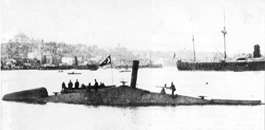
Discussions between the English reverend, George Garrett, and the industrially and commercially adept Swede, Thorsten Nordenfelt, led to a series of steam powered submarines. The first was the Nordenfelt I, a 56-ton, 19.5 meter vessel similar to Garret's ill-fated Resurgam (1879), with a range of 240 kilometers and armed with a single torpedo in 1885. Like the Resurgam, it operated on the surface by steam and shut down its engine to dive. Greece, fearful of the return of the Ottomans, purchased it. Nordenfelt then built the Nordenfelt II (AbdĂŒlhamid) in 1886 and Nordenfelt III (AbdĂŒlmecid) in 1887, a pair of 30-meter submarines with twin torpedo tubes, for the Ottoman Navy. AbdĂŒlhamid became the first submarine in history to fire a torpedo while submerged under water. Nordenfelt's efforts culminated in 1887 with the Nordenfelt IV which had twin motors and twin torpedoes. It was sold to the Russians, but proved unstable, ran aground and was scrapped.
Another fully capable military submarine was the electrically-powered vessel built by the Spanish engineer and sailor, Isaac Peral, for the Spanish Navy. It was launched on September 8, 1888. It had two torpedoes, new air systems, a hull shape, propeller and cruciform external controls anticipating much later designs. Its underwater speed was ten knots, but it suffered from the short range and difficulty of recharging at sea of battery powered systems. In June 1890, Peral's submarine launched a torpedo while submerged under the sea. The Spanish Navy scrapped the project.
Another major submarine development was the French Gymnote, launched in 1888, often considered as the first fully functional modern submarine. The electrically-powered Gymnote completed two thosand dives successfully.
Many more submarines were built at this time by various inventors, but they were not to become effective weapons until the twentieth century.
Late nineteenth century to World War I
The turn of century era marked a pivotal time in the development of submarines, with a number of important technologies making their debut, as well as the widespread adoption and fielding of submarines by a number of nations. Diesel-electric propulsion would become the dominant power system and things such as the periscope would become standardized. Large numbers of experiments were done by countries on effective tactics and weapons for submarines, all of which would culminate in them making a large impact on coming World War I.
In 1895, Irish inventor John Philip Holland designed submarines that, for the first time, made use of internal combustion engine power on the surface and electric battery power for submerged operations. In 1902 Holland received U.S. patent 708553 . Some of his vessels were purchased by the United States, the United Kingdom, the Imperial Russian Navy, and Japan, and commissioned into their navies around 1900 (1905 for Japan, too late to serve in the war).
Commissioned in June 1900, the French steam and electric submarine Narval introduced the classic double-hull design, with a pressure hull inside the outer light hull. These 200-ton ships had a range of over 100 miles on the surface, and over 10 miles underwater. The French submarine Aigrette in 1904 further improved the concept by using a diesel rather than a gasoline engine for surface power. Large numbers of these submarines were built, with 76 completed before 1914.
Submarines during World War I
Military submarines first made a significant impact in World War I. Forces such as the U-boats of Germany saw action in the First Battle of the Atlantic, and were responsible for the sinking of the RMS Lusitania, which receives much of the credit for prompting the United States to enter the war.
The U-boats' ability to function as practical war machines relied on new tactics, their numbers, and submarine technologies such as combination diesel-electric power system that had been developed in the preceding years. More like submersible ships than the submarines of today, U-boats operated primarily on the surface using regular engines, submerging occasionally to attack under battery power. They were roughly triangular in cross-section, with a distinct keel to control rolling while surfaced, and a distinct bow.
In 1916, a Serbian pilot named Konjovic, flying with the Austro-Hungarian air service, bombed and sank the French submarine Foucault in the Adriatic Sea, thus becoming the first man to sink a submarine from the air. Spotting survivors in the water, he landed his flying boat and rescued them, an act for which the French government awarded him a special recognition in 1968.
Interwar developments
Various new submarine designs were developed during the interwar years. Among the most notorious ones were submarine aircraft carriers, equipped with waterproof hangar and steam catapult and which could launch and recover one or more small seaplanes. The submarine and her plane could then act as a reconnaissance unit ahead of the fleet, an essential role at a time when radar still did not exist. The first example was the British HMS M2, followed by the French Surcouf, and numerous aircraft-carrying submarines in the Imperial Japanese Navy. The 1929 Surcouf was also designed as an "underwater cruiser," intended to seek and engage in surface combat.
Submarines during World War II
Germany
Germany had the largest submarine fleet during World War II. Due to the Treaty of Versailles limiting the surface navy, the rebuilding of the German surface forces had only begun in earnest a year before the outbreak of World War II. Having no hope of defeating the vastly superior Royal Navy decisively in a surface battle, the German High Command immediately stopped all construction on capital surface ships save the nearly completed Bismarck-class battleships and two cruisers and switched the resources to submarines, which could be built more quickly. Though it took most of 1940 to expand the production facilities and get the mass production started, more than a thousand submarines were built by the end of the war.
Germany put submarines to devastating effect in the Second Battle of the Atlantic in World War II, attempting but ultimately failing to cut off Britain's supply routes by sinking more ships than Britain could replace. The supply lines were vital to Britain for food and industry, as well as armaments from the United States. Although the U-boats had been updated in the intervening years, the major innovation was improved communications, encrypted using the famous Enigma cipher machine. This allowed for mass-attack tactics or "wolf packs," (Rudel), but was also ultimately the U-boats' downfall.
After putting to sea, the U-boats operated mostly on their own trying to find convoys in areas assigned to them by the High Command. If a convoy was found, the submarine did not attack immediately, but shadowed the convoy to allow other submarines in the area to find the convoy. These were then grouped into a larger striking force and attacked the convoy simultaneously, preferably at night while surfaced.
From September 1939 to the beginning of 1943, the Uboatwaffe scored unprecedented success with these tactics, but were too few to have any decisive success. By the spring of 1943, German U-boat construction was at full capacity, but this was more than nullified by equally increased numbers of convoy escorts, aircraft, and technical advances like radar and sonar. Huff-Duff and Ultra allowed the Allies to route convoys around wolf packs when they detected them from their radio transmissions. The results of Allied efforts were devastating: from March to July of that year, over 130 U-boats were lost, one-third of which were lost in May alone (41 boats). Allied losses dropped dramatically in the same period, from 750,000 tons in March to only 188,000 in July. Although the Second Battle of the Atlantic would continue to the last day of the war, the U-boat arm was unable to stem the tide of men and material, paving the way for Operation Torch, Operation Husky, and ultimately, D-Day.
Winston Churchill wrote that the U-boat "peril" was the only thing that ever gave him cause to doubt the Allies' eventual victory.
Japan
Japan had the most varied fleet of submarines of World War II, including manned torpedoes (Kaiten manned torpedo), midget submarines (Ko-hyoteki-class, Kairyu-class), medium-range submarines, purpose-built supply submarines (many for use by the army), long-range fleet submarines (many of which carried an aircraft), submarines with the highest submerged speeds of the conflict (Sen taka I-200-class), and submarines that could carry multiple bombers (the war's largest submarine, the Sen toku I-400-class). These submarines were also equipped with the most advanced torpedo of the conflict, the oxygen-propelled Type 95. Overall, despite their technical prowess, Japanese submarines were relatively unsuccessful. They were often used in offensive roles against warships, which were fast, maneuverable and well-defended compared to merchant ships. In 1942 Japanese submarines sank two aircraft carriers among other warships, but were not able to sustain these results afterwards. By the end of the war, submarines were instead often used to transport supplies to island garrisons.
United States
The United States used its submarine force to attack merchant shipping (commerce raiding or guerre de course), its submarines destroying more Japanese shipping than all other weapons combined.
Where Japan had the finest submarine torpedoes of the war, the U.S. Navy had perhaps the worst. One attempt to correct the problems resulted in a wakeless, electric torpedo being placed in service, but the losses of two boats resulted from self-inflicted hits by these torpedoes, and contributed to a third before the boat was bombed by aircraft.
During World War II, 314 submarines served in the United States Navy. One hundred eleven boats were in commission on December 7, 1941, and 203 submarines from the Gato-, Balao- and Tench- classes were commissioned during the war. Fifty-two boats with 3,506 men were lost during hostilities. U.S. submarines sunk 1,392 enemy vessels of a total tonnage of 5.3 million tons, including eight aircraft carriers and over two hundred warships.
The Schnorchel
Diesel submarines need air to run their engines, and so carried very large batteries for submerged travel. These limited the speed and range of the submarines while submerged. The schnorchel (a prewar Dutch invention) was used to allow German submarines to run just under the surface, attempting to avoid detection visually and by radar. The German navy experimented with engines that would use hydrogen peroxide to allow diesel fuel to be used while submerged, but technical difficulties were great. The Allies experimented with a variety of detection systems, including chemical sensors to "smell" the exhaust of submarines.
Modern submarines
In the 1950s, nuclear power partially replaced diesel-electric propulsion. Equipment was also developed to extract oxygen from sea water. These two innovations gave submarines the ability to remain submerged for weeks or months, and enabled previously impossible voyages such as USS Nautilus' crossing of the North Pole beneath the Arctic ice cap in 1958 and the USS Triton's circumnavigation of the world in 1960. Most of the naval submarines built since that time in the United States and the Soviet Union/Russia have been powered by nuclear reactors. The limiting factors in submerged endurance for these vessels are food supply and crew morale in the space-limited submarine.
While the greater endurance and performance from nuclear reactors mean that nuclear submarines are better for long distance missions or the protection of a carrier battle-force, conventional diesel-electric submarines have continued to be produced by both nuclear and non-nuclear powers, as they can be made stealthier, except when required to run the diesel engine to recharge the shipâs battery. Technological advances in sound dampening, noise isolation and cancellation have substantially eroded this advantage. Though far less capable regarding speed and weapons payload, conventional submarines are also cheaper to build. The introduction of air-independent propulsion boats led to increased sales numbers of such types of submarines.
During the Cold War, the United States and the Soviet Union maintained large submarine fleets that engaged in cat-and-mouse games; this tradition today continues, on a much-reduced scale. The Soviet Union suffered the loss of at least four submarines during this period: K-129 was lost in 1968 (which the Central Intelligence Agency attempted to retrieve from the ocean floor with the Howard Hughes-designed ship named Glomar Explorer), K-8 in 1970, K-219 in 1986 (subject of the film Hostile Waters), and Komsomolets in 1989 (which held a depth record among military submarinesâ1000Â meters). Many other Soviet subs, such as K-19 (the first Soviet nuclear submarine and the first Soviet sub to reach the North Pole) were badly damaged by fire or radiation leaks. The United States lost two nuclear submarines during this time: USS Thresher and USS Scorpion. Thresher was lost due to equipment failure, and the exact cause of the loss of Scorpion is not known, though is thought by many to have been a faulty torpedo.
The sinking of PNS Ghazi in the Indo-Pakistani War of 1971 was the first submarine casualty in the South Asian region. The United Kingdom employed nuclear-powered submarines against Argentina in 1982 during the Falklands War. The sinking of the cruiser General Belgrano by HMS Conqueror was the first sinking by a nuclear-powered submarine in wartime.
Major submarine incidents since 2000
Since submarines have been actively deployed, there have been several incidents involving submarines which were not part of major combat. Most of these incidents were during the Cold War, but some are more recent. Since 2000, there have been nine major naval incidents involving submarines. There were three Russian submarine incidents, in two of which the submarines in question were lost, along with three United States submarine incidents, one Chinese incident, one Canadian, and one Australian incident. In August 2005, the Russian Priz, an AS-28 rescue submarine was trapped by cables and/or nets off of Petropavlovsk, and saved when a British ROV cut them free in a massive international effort.
Submarine movies
A genre of submarine movies has developed. Submarines are popular subjects for films due to the danger, drama and claustrophobia of being on a submarine, and the suspense of the cat-and-mouse game of submarine or anti-submarine warfare. One of the first, based on a classic book, was Run Silent, Run Deep. Modern movies include The Hunt for Red October, Das Boot, U-571, Crimson Tide and The Enemy Below. K-19: The Widowmaker is about the first of many disasters that befell the Soviet submarine K-19. Operation Petticoat is a Cary Grant comedy from 1959 about a World War II submarine. Another comedy about a diesel submarine, Down Periscope, stars Kelsey Grammer.
Notes
- â Physics Of Liquids & Gases. Elementary Classical Physics. Retrieved June 6, 2007.
- â Kennedy, Harold. âVirginia-Class Boats Portend New Ship-Building Approach.â National Defense (May 2000). Retrieved June 6, 2007.
- â âRun Silent, Run Deep.â Federation of American Scientists. Retrieved June 6, 2007.
- â U.S. Naval Academy Coursebook: Principles of Ship Performance, Chap. 10. Retrieved June 6, 2007.
- â âNew Debate on Submarine Duty for Women.â Armedforcescareers.com.
- â 6.0 6.1 Submarine History. Globalsecurity.org. Retrieved June 6, 2007.
ReferencesISBN links support NWE through referral fees
- Blair, Clay Jr. (2001). Silent Victory: The U.S. Submarine War Against Japan. Annapolis, MD: Naval Institute Press. ISBN 155750217X
- Gardiner, Robert and Andrew Lambert (eds.). (2001). Steam, Steel and Shellfire: The Steam Warship, 1815-1905. Book Sales. ISBN 0785814132
- Lockwood, Charles A. (1951). Sink 'Em All: Submarine Warfare in the Pacific. New York: Dutton. ASIN B0007E0BVC
- O'Kane, Richard H. (1996). Clear the Bridge! The War Patrols of the USS Tang. New York: Presidio Press. ISBN 0891413464
- O'Kane, Richard H. (1987). Wahoo: The Patrols of America's Most Famous WWII Submarine. New York: Presidio Press. ISBN 0891413014
- Werner, Herbert A. (2002). Iron Coffins. Cambridge, MA: Da Capo Press. ISBN 030681160X
External links
All links retrieved February 26, 2023.
History
- Biography of John Holland â Inventor of the modern submarine
- Holland Submarine Exhibit - Photos John Holland's Submarine #1 and his second submarine, The Fenian Ram
- Submarines of World War I
Germany
- uboat.net â The U-boat War 1939-1945
- Deutsche U-Boote 1935-1945 â In German
- German Midget Submarine - Molch
- Photos of a Seehund â German coastal defense submarine from World War II
Japan
United Kingdom
- History of Royal Navy Submarines from the Royal Navy, Ministry of Defence
United States
- NavSource Naval History: Photo Archive â U.S. ship photo archive.
- On Eternal Patrol â A tribute and history site for lost submarines in World War II
Credits
New World Encyclopedia writers and editors rewrote and completed the Wikipedia article in accordance with New World Encyclopedia standards. This article abides by terms of the Creative Commons CC-by-sa 3.0 License (CC-by-sa), which may be used and disseminated with proper attribution. Credit is due under the terms of this license that can reference both the New World Encyclopedia contributors and the selfless volunteer contributors of the Wikimedia Foundation. To cite this article click here for a list of acceptable citing formats.The history of earlier contributions by wikipedians is accessible to researchers here:
The history of this article since it was imported to New World Encyclopedia:
Note: Some restrictions may apply to use of individual images which are separately licensed.
